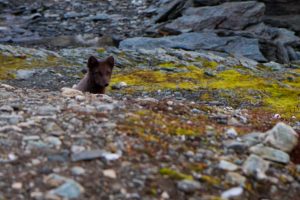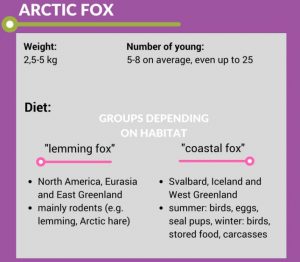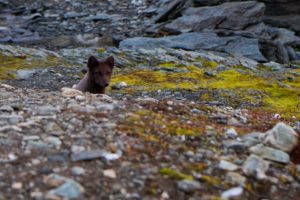Arctic fox
The Arctic fox, (Vulpes lagopus) also known as the “polar fox” lives in the Arctic tundra of Eurasia and North America, Iceland, Greenland, and Svalbard, as well as the islands off the north coasts of Siberia, and Canada.
In the summer, it has thinner brown, dark brown or yellow fur, and in winter, it is thick and white. The fur colour allows it to be camouflaged against predators (polar bears, wolverines, golden eagles), but starvation during the winter is likely to be the main cause of mortality.
Polar foxes live in large dens with more than one entrance, which might be in use for several years. Sometimes young non-breeding foxes (mainly females) might live in the same den, and help to raise the pups. In the winter, the den may be made inside a snowbank. Mating season takes place from February until April. Pups are born in a den in May or June.
In the summer and autumn, polar foxes store extra food under rocks in their den or even in holes dug into the permafrost. The extra food is used during the winter when the food is scarce.
Arctic foxes live on average 3-4 years (on Svalbard the longest recorded lifespan for the fox was 16 years old).
Interesting facts
Genetic studies indicate that there is significant contact between separate populations of polar foxes. It is hypothesized that they might use sea ice to move over long distances across the Arctic.
Among the many threats to Arctic foxes there is the northern encroachment of the bigger and more aggressive red fox due to climate change. It may be a considerable rival for the polar fox in his traditional Arctic habitat.
- Arctic fox in his summer fur (author: Piotr Andryszczak)
- Arctic fox (author: Dagmara Bożek-Andryszczak)





 This project (EDU-ARCTIC) has received funding from the European Union’s Horizon 2020 research and innovation programme under grant agreement No 710240. The content of the website is the sole responsibility of the Consortium and it does not represent the opinion of the European Commission, and the Commission is not responsible for any use that might be made of information contained.
This project (EDU-ARCTIC) has received funding from the European Union’s Horizon 2020 research and innovation programme under grant agreement No 710240. The content of the website is the sole responsibility of the Consortium and it does not represent the opinion of the European Commission, and the Commission is not responsible for any use that might be made of information contained.